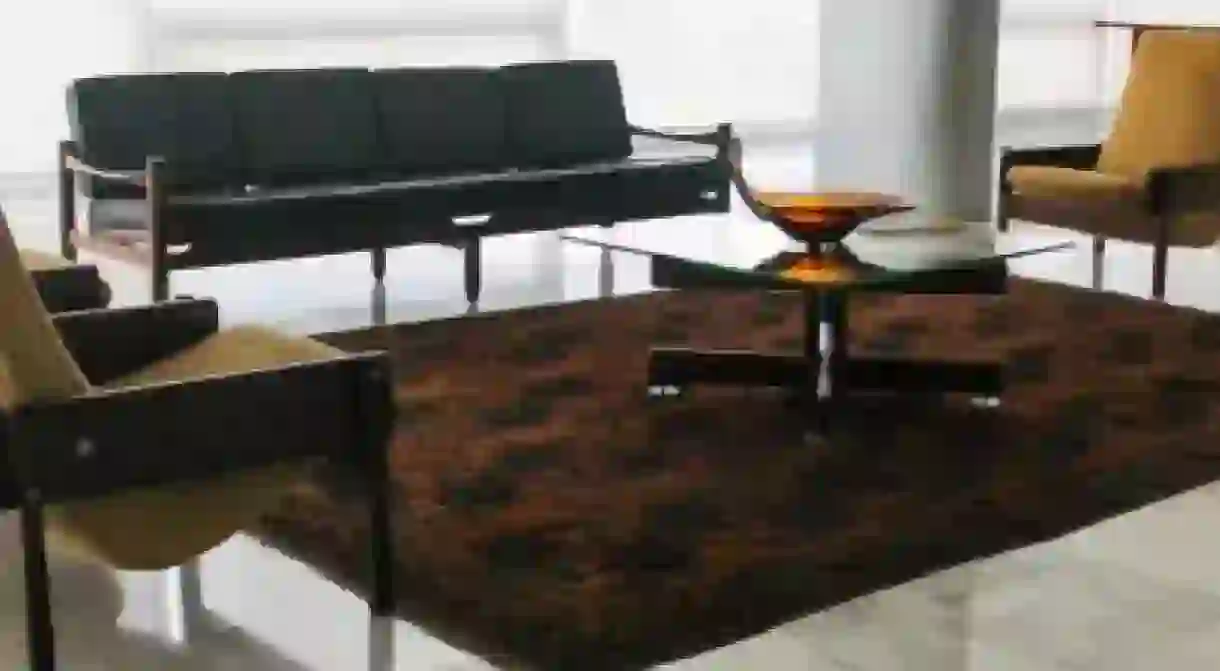Sergio Rodrigues And His Iconic Brazilian Furniture Design

Dissolving the boundaries between architect, designer and artist, the late Sergio Rodrigues evaded definition. Initially trained as an architect, Rodriguez translated Modernist architecture into high-class furniture. His chairs and tables have come to be considered as more than just furniture – they are functional sculptures. Discover more about the life and work of this icon of Brazilian design.

The son of a graphic artist, Rodrigues was born in Rio de Janeiro – in the bustling urban home of Brazilian design. After graduating from design school, Rodrigues realized that interior design had not kept pace with Modernist architecture in Brazil. In the 1950s, he began working on furniture that reflected Modernist style whilst embodying the characteristic Brazilian humor and relaxed character.
Whilst many designers at this time were embracing steel and Formica, Rodrigues was keen to stick to traditional, natural materials. His decision to use native Brazilian wood in his designs shows his dedication to his country and to the materials he knew and loved. It is clear from his designs that he understood his materials – their capabilities and origins. His sympathetic approach to materials allowed him to reveal the ‘expressive potential’ of the wood, creating objects that are equally functional and beautiful.
Mole (meaning soft in Portuguese) is perhaps his most renowned work. Upon a delicate wooden frame sits a large leather cushion, extending from the head to the knees with two overlapping wings at the arms. Reminiscent of a father’s hug, the chair embraces the sitter with its reassuring grip and soft comfort. The natural materials of Brazilian wood and leather, alongside the button detailing on the seat, also make this a remarkable fusion of traditional design elements in a piece Modernist furniture.

One of his more luxurious armchairs, Voltaire is also a thing of beauty. The seat cradles the sitter in red velvet, with a fluid mix of curves and straight forms creating an eloquent dialogue between the furniture and the human body. The winged-back style harks back to Chesterfield furniture while supporting the head and offering rest and an opportunity to sleep. Again, a geometric dark-wood frame supports the seat, adding connotations of elegance and sophistication.
Aside from the complete comfort of Mole and Voltaire, Rodrigues explored more practical designs in Taja and Katita. Taja resembles a vintage school chair, subtly renewing the design with tapering angles, a polished sheen and a perfect, circle piercing the chair back. Taja still retains elements of its utilitarian purpose through the simplicity, the paneled style and the rows of dark pegs holding everything in place. This chair is a prime example of what Rodrigues does best, refining classic design and transforming it into something unique, modern and exciting.
Katita is also an embodiment of elegant practicality, although it appears much more futuristic than many of his other designs. In many ways, Katita can be considered one of his more organic constructions. The tapering of the legs, the arches of the struts and the delicate flick at the end of the arms have all the naturalness of branches. The seat itself resembles a succulent leaf of black leather. This homage to nature also has elements of the primitive. The seat back with its two round holes is like a tribal mask. Perhaps, like a primitive man, this design is symbolic of the harmony between man and nature – Rodrigues working with nature to create a work of art.
Diz is an intermediary between the slouching armchairs and the straight backed working furniture. The supple shapes of the curvaceous wood wrap around the human body with ergonomic sensitivity. Rodrigues’ understanding of his materials is obvious in this chair. The vibrant ochre’s and reds of the wood grain are exploited by the wide surfaces and waxed finish. The slim leather seat pad picks out the tan hues of the wood and enhances them, encouraging harmony between color, material and design.
One of Rodrigues’ great classic works is Oscar. The spindly orange wood again has an organic quality, less like branches and more like blades of grass. The wood has a sway as it tapers in and out in a continuous, graceful line. The curves of the forms are balanced with the straight horizontal struts between the back and front legs of the chair. The woven seat uses traditional techniques, whilst providing comfort and strength to a delicate material. The pattern of the weave along with the quarter-circle piercings on the seat demonstrate the interplay between mass and void that was so intrinsic to Modernist architecture. Oscar rejuvenates traditional techniques and ensured that similar designs will be found in homes for decades to come.
Sergio Rodrigues can truly be described as the icon of Brazilian furniture design. Not only did Rodrigues set a standard for Modernist furniture – in introducing Brazilian design to the world – he also legitimized Brazilian interior design through forming a consultancy and designing himself. In the words of Carlos Junqueira, ‘before him, there was no importance given to furniture design in Brazil. He was the first to whom people looked for inspiration.’ Rodrigues’ legacy did not die with him – across the world, furniture designers continue to look to his work as a stimulus for their own designs. Demonstrating reverence for his materials, respect for classic design and his own brand lead to Sergio Rodrigues creating numerous works of functional eloquence which are now classics in their own right













